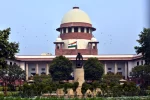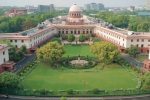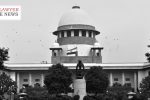suspicion howsoever strong cannot take place of proof – SC

D.D:-27.05.2022
Apex Court held in recent judgement (CHANDRAPAl Vs STATE OF CHHATTISGARH D.D 27/05/2022) that the accused “must be” and not merely “may be” guilty before a court can convict him. The conclusions of guilt arrived at must be sure conclusions and must not be based on vague conjectures.
Facts – Deceased Kumari Brindabai belonged to the caste Kumhar and deceased Kanhaiya Siddar belonged to the caste Siddar (Gaur). There was a love affair going on between Kumari Brindabai and Kanhaiya Siddar, which the Bhagirathi father of girl and her brother Chandrapal did not approve. On 02.12.1994, both Kumari Brinda and Kanhaiya went missing. A search was made; however, no missing report was lodged. On 11.12.1994, at about 09:00 am, Lodhu (PW-2) went to Cashew Nursery and saw that the dead bodies of the deceased Kumari Brinda and Kanhaiya were hanging on a cashew tree. He therefore came back and informed the Sarpanch Baran Singh Thakur. Their bodies were in decomposed state and were not identifiable, however the informant Chandrapal identified the dead bodies.
In the postmortem report of the deceased Kumari Brinda, it was opined that the ligature mark over her neck was antemortem in nature, and the cause of death appeared to be Asphyxia due to hanging. In the postmortem report of the deceased Kanhaiya also, it was opined that the cause of death appeared to be Asphyxia due to hanging. In both the postmortem reports, it was stated that the death had occurred within 8 to 10 days and the nature of the death was suicidal. As per the further case of the prosecution, on 02.12.1994, the deceased Kanhaiya was sitting at the premises of village Panchayat, where some TV program was going on.
At that time the accused Chandrapal called Kanhaiya and took him to his house, shut him down in the room and all the accused i.e., Bhagirathi, Chandrapal, Mangal Singh and Videshi in furtherance of their common intention pressed his neck and committed his murder. Thereafter, the accused Mangal Singh and Videshi committed the murder of Kumari Brinda. Then took the dead bodies to Cashew nursery. The accused thereafter hanged the dead bodies of both the deceased by tying the noose in their necks with the tree of cashew in the Cashew nursery and attempted to give it the shape of their having committed suicide. Aggrieved Chandrapal approached the Apex Court.
Session Court acquitted all the accused from the charges levelled against them under section 3(2)(v) of the SC ST Act but convicted all the accused U/s 302, 201 and 34 of IPC.
The High Court vide the impugned judgement and order, confirmed the conviction and sentence imposed on the accused no. 2 Chandrapal for the offence U/s 302 ,201,34 IPC. However, the High Court set aside the conviction and sentence imposed on the accused Bhagirathi Kumhar, Mangal Singh and Videshi for the offence U/s 302 ,201,34 IPC.
Ground of Appeal – Appellant argued that there were serious discrepancies in their evidence about Videshi’s extrajudicial confession, and that conviction cannot be founded on such weak evidence. Refuting the “last seen theory,” he said PW1 Dhan Singh’s statement, who had purportedly last seen Kanhaiya, was recorded 4 months after the occurrence. Even according to the prosecution, the appellant called Kanhaiya 10 days before the dead bodies were found in Kajubadi. Given the long-time gap between the day the deceased was allegedly last seen with the appellant and the day his body was found, it was risky to convict the appellant solely on such evidence. He also said the postmortem doctor said the cause of death was asphyxia from hanging and was suicide. Without clear or convincing evidence, both courts erred in convicting the appellant.
Apex Court observed that undisputedly the entire case of the prosecution rested on the circumstantial evidence, as there was no eyewitness to the alleged incident. The law on the appreciation of circumstantial evidence is also well settled. The circumstances concerned “must or should be” established and not “may be” established. The conclusions of guilt arrived at must be sure conclusions and must not be based on vague conjectures. The entire chain of circumstances on which the conclusion of guilt is to be drawn, should be fully established and should not leave any reasonable ground for the conclusion consistent with the innocence of the accused.
Apex Court further observed that the High Court in its impugned judgment has not considered the evidence of Dr. R.K. Singh to concluded whether the deaths of Brinda and Kanhaiya were homicidal or suicide. It was imperative for the prosecution to prove beyond reasonable doubt that it was homicidal deaths and not suicidal.
Apex court while analyzed the Extra Judicial Confession observed that an extra judicial confession is a weak kind of evidence and unless it inspires confidence or is fully corroborated by some other evidence of clinching nature, ordinarily conviction for the offence of murder should not be made only on the evidence of an extra judicial confession.
Apex Court held that High Court surprisingly considered the said extra judicial confession made by Videshi as an incriminating circumstance against the appellant Chandrapal. The High Court could not have used the said evidence against the present appellant for the purpose of holding him guilty for the alleged offence. In our opinion if such weak piece of evidence of Videshi was not duly proved or found trustworthy for holding the other co-accused guilty of committing murder of the deceased Brinda and Kanhaiya.
While considering the “Last seen together” theory of prosecution Apex Court observed that Dhan Singh had seen the accused Chandrapal calling the deceased Kanhaiya and taking him inside his house on the fateful night. The time gap between the two incidents i.e. the day the accused was last seen and the day Kanhaiyas body was found being quite big, it is difficult to connect the present appellant with the alleged crime. The last-seen theory comes into play where the time-gap between the point of time when the accused and the deceased were last seen alive and when the deceased is found dead is so small that possibility of any person other than the accused being the author of the crime becomes impossible.
Apex Court held that High Court had committed error in convicting the appellant-accused for the alleged charge of 302 read with 34 of IPC. The suspicion howsoever strong cannot take place of proof. No evidence worth the name as to how and by whom the deceased Brinda was allegedly murdered was produced by the prosecution. Under the circumstances, it is required to be held that the prosecution had miserably failed to bring home the charges levelled against the appellant-accused beyond reasonable doubt. The suspicion howsoever strong cannot take place of proof. Appeal Allowed – Accused Acquitted.
CHANDRAPAL
VERSUS
STATE OF CHHATTISGARH
[arm_setup id=”2″ hide_title=”true”]






